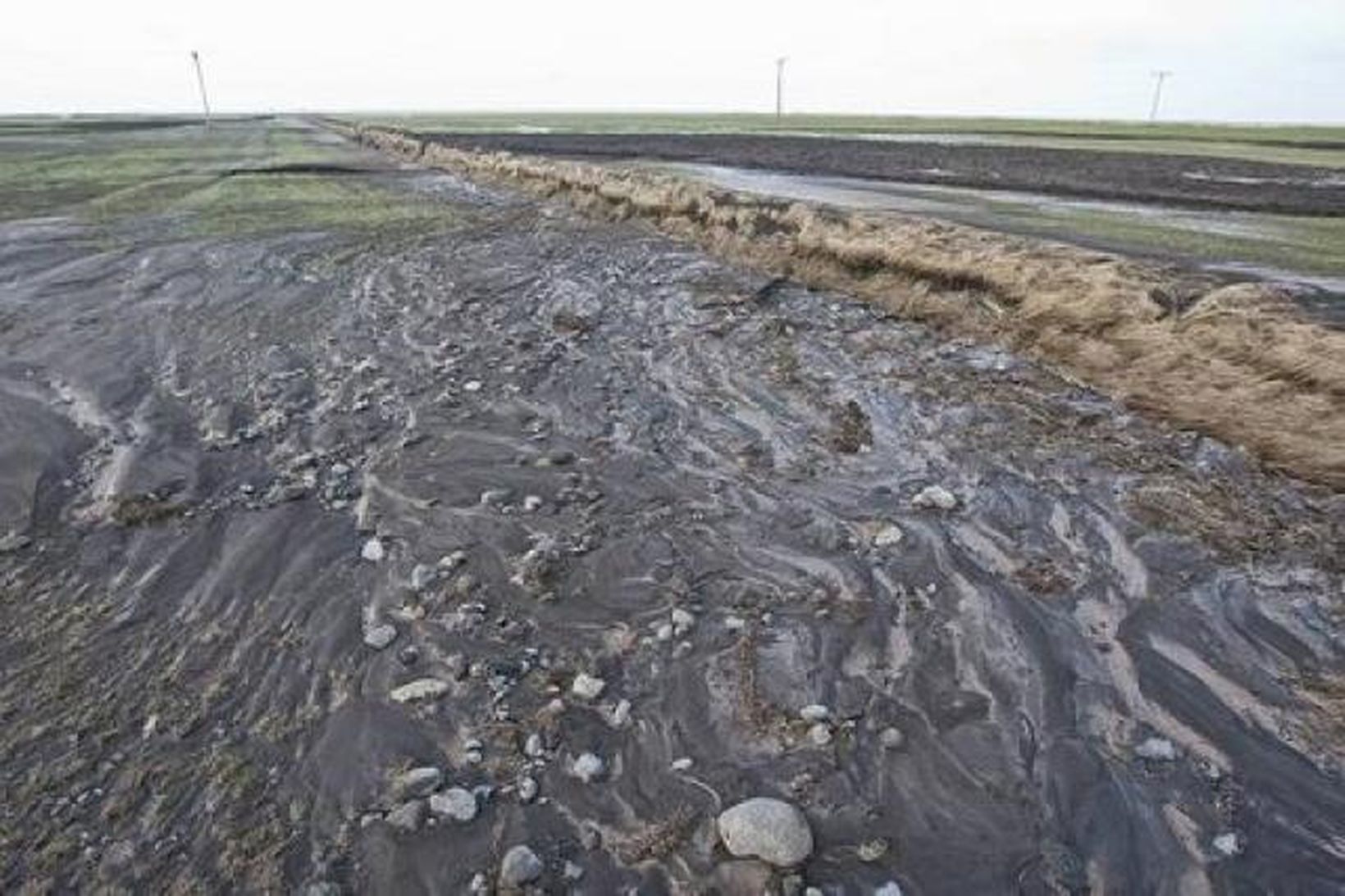Emergency evacuation in response to flash flooding went well.
Harður leir er yfir stórum hluta túnana.
Ómar Óskarsson
The emergency evacuation implemented last night in response to flash flooding went well. Local residents, with the exception of 20 farms, were able to return to their homes when it became clear that flood barriers had held back the flood water. There was no need for further evacuations during the night despite two additional flash floods that originated from the Gígjökull lagoon.
The flooding did, however, cause widespread damage. A 400m section National route 1to the east of Markarfljótsbrú and sections of the road to the east Seljalandsá river have been washed away. National route 1 is closed from Þverá, which is to the east of Hvolsvöllur to Þorvaldseyri. The road close to Bleiksá river, in Fljótshlíð, is impassable in places. The weather forecast for the affected area indicates westerly winds during the day becoming northerly in the evening.
Volcanic ash can be expected to fall on the area to the south of the glacier during the evening and night. The volcanic ash particles are very fine and have been compared to flour and sugar in size. The Flourine content of the ash is high and presents a health risk to livestock in areas where the ash layer is more than 1 cm thick.
Health hazards of volcanic ash
There is considerable ash fall resulting from the volcanic eruption under the Eyjafjallajökull glacier. The ash that is falling is composed of fine and course particles. The wind direction and other meteorological conditions have an impact on where the ash falls to earth.
The most common effects are.
Respiratory effects: Common short-term symptoms include:
Nasal irritation and discharge (runny nose).
Throat irritation and sore throat, sometimes accompanied by dry coughing.
Breathing becomes uncomfortable.
People with pre-existing chest complaints may develop severe bronchitic symptoms which last some days beyond exposure to ash (for example, hacking cough, production of sputum, wheezing, or shortness of breath). Airway irritation for people with asthma or bronchitis; common complaints of people with asthma include shortness of breath, wheezing and coughing.
Eye irritation is a common health effect as pieces of grit can cause painful scratches in the front of the eye and conjunctivitis. Contact lens wearers need to be especially ware of this problem.
Eye symptoms: Common short-term symptoms include:
Eyes feeling as though there are foreign particles in them.
Eyes becoming painful, itchy or bloodshot.
Sticky discharge or tearing
Corneal abrasions or scratches.
Acute conjunctivitis or inflammation due to the presence of ash, which leads to redness, burning of the eyes, and photosensitivity.
What you can do to protect yourself against volcanic ash,
Use a mask when outside, and it is also recommended to wear protective clothing.
If a mask is not available the use a cloth over the mouth and nose to prevent inhalation of larger particles.
Use protective goggles.
Children and adults with respiratory problems should remain indoors. Houses should be well heated so that an overpressure in the house maintained. This reduces the likelihood that ash seeps into the house.



 Einn handtekinn út af þjófnaðinum í Hamraborg
Einn handtekinn út af þjófnaðinum í Hamraborg
/frimg/1/28/6/1280672.jpg) Gripinn með tvær milljónir á Keflavíkurflugvelli
Gripinn með tvær milljónir á Keflavíkurflugvelli
 Stjórnvöld hafa tvo mánuði til að bregðast við
Stjórnvöld hafa tvo mánuði til að bregðast við
 Telur loftslagsdóm MDE rangan
Telur loftslagsdóm MDE rangan
 „Ættir þú ekki frekar að bjóða þig fram til Alþingis?“
„Ættir þú ekki frekar að bjóða þig fram til Alþingis?“
 Sólarsellur verði á 10 til 20% íslenskra þaka
Sólarsellur verði á 10 til 20% íslenskra þaka
 Framboð Viktors metið gilt
Framboð Viktors metið gilt
 Dómari vanhæfur í Hvammsvirkjunarmáli
Dómari vanhæfur í Hvammsvirkjunarmáli